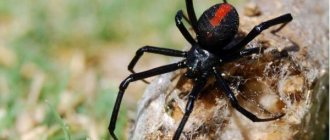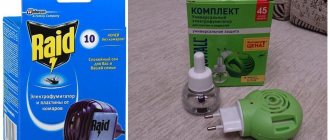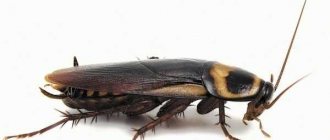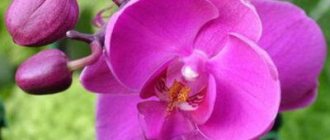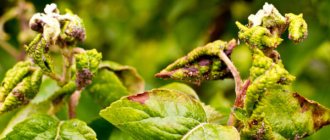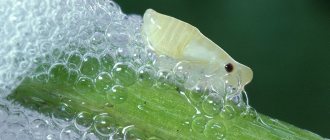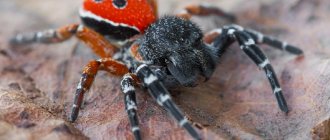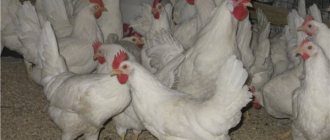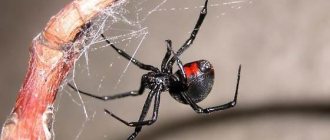In spring, nature awakens, and summer residents rush to start working on their plots. The first leaves on roses and fruit trees, as well as seedlings that are finally moving into the open ground - all this cannot but rejoice. But it’s too early to relax: if you turn over this curled leaf, you can see aphids. This insect is a gourmand, preferring young shoots and sprouts, and can cause serious harm to the plant, slow down its development and deprive summer residents of a significant share of the harvest. This means that aphids need to be fought.
general information
Aphids settle on plants and begin to suck the juices out of them, forming necrotic areas .
One single individual will not cause serious harm, but the problem is that small pests multiply quickly and form numerous colonies. In this regard, it is necessary to take various methods and methods of struggle.
The larger the aphid population, the more plants will die due to their activity. Some species are even considered quarantine pests , for example, grape phylloxera. You can see what different types of aphids look like in the photos posted in our article.
Other varieties produce galls and other plant development pathologies.
Reproduction and lifespan of aphids
There are aphids that lay eggs. But there are also insects that are called viviparous. Parthenogenesis is inherent in many species of these insect pests. Some of the aphids come into the world with wings and different sexes. Others are the opposite.
A major role in the continuation of the aphid species is played by winged individuals, who do not allow their own kind to die of hunger, but move to new territories in search of food for themselves.
Scientists have noticed that winged aphids often appear if, for example, there are a large number of ladybugs in the area. The whole process is very complicated. But if we briefly try to explain it, then everything happens as follows.
The ladybug finds its prey and eats it. As a result, the aphids produce a specific aromatic substance, which is captured by all aphids in the colony. This causes panic. In such a panic, more aphids with wings are born.
This insect is not long-lived. Aphids can live for several days or months. With the onset of frost, it all dies. Except for the one that was given shelter by the rescue ants.
Peach
There are two known subspecies - the large peach aphid and the greenhouse (also known as tobacco and green) aphid.
Big
The founder has a rounded body of a brownish-gray color, up to 5 mm long. The head is black with short antennae. There are two tubercles on the abdomen and chest. The male is the same color, but smaller in size. There are no wings .
The winged virgin is distinguished by its shorter body length - up to 4.5 mm, the color of the head and chest is black, the back and abdomen are gray and brown. The wingless virgin has a gray pear-shaped body, covered, like its head, with black spots. The legs are bright - yellow and orange.
The eggs are initially orange in color , which gradually darkens and turns brown. After a few days it darkens, the eggs turn black.
- Geographical distribution. Steppe regions and Crimea.
- On what plants is it found? Prefers fruit and nut trees - cherry plum, peach, almond, apricot, plum.
- Features of development and life cycle. They have a monoecious development cycle. Large clusters of eggs are sent to winter, located on the inside of large branches and under the bark of the trunk. In April, the larvae appear and begin to actively feed, going through the development cycle to an adult within a month.
From the founder, 50-80 larvae appear, from wingless virgins, on average - 30. The third and subsequent generations reproduce very intensively. Winged virgins appear in mid-summer and begin to actively fly to other trees, forming new colonies.If no action is taken, by August aphid populations will completely cover all the trees in the garden, settling on the inside of leaves and branches. During the season, 8-10 generations of the pest are formed. Males are born in the fall and fertilize females to produce overwintering eggs.
- What harm does it cause? By sucking juices from trees, aphids cannot completely destroy the plant. However, its activity weakens the tree’s defenses, which leads to the development of various viral diseases. In addition, it gives way to sooty fungi that settle on the sweet secretions of aphids. Externally, a fungal invasion appears as black wet spots.
Green or tobacco peach
The founder has an oval body , greenish-yellow in color, sometimes with a pink tint. It reaches no more than 2.5 mm in length.
The wingless virgin is smaller in size, the body is colored pink, green-yellow or light green. The eyes are red, the antennae are light and short . The average length is 1.5 - 2 mm.
The winged virgin differs from the wingless one; the main color of the body is yellow-green, the head and chest are black. The wings are colorless and transparent.
The eggs are elongated and elliptical in shape. The color is black with a metallic sheen.
- Geographical distribution. North America, Asia (especially Japan, China and India), Eastern and Western Europe, Southern Urals.
- On what plants is it found? A very indiscriminate species that lives on peaches, cherry plums, plums, tobacco, cabbage, cucumbers, eggplants, potatoes, peppers, radishes, dill and parsley, lettuce and many other plants, including greenhouse crops and medicinal herbs.
- Features of development. Development is fully cyclical or incompletely cyclical (during life in greenhouses). Foundress larvae emerge from overwintered eggs in March - April. The air temperature should be at least 20°. They begin to feed on the kidneys. Development to a sexually mature individual from 18 to 28 days. The founder gives about 30-60 eggs of offspring. The maximum increase in population is observed in mid-summer. Up to 12 generations can develop during a season. The eggs spend the winter at the base of the buds.
- What harm does it cause? The most significant damage is observed on young shoots and various vegetable crops, as well as tobacco. Leaves curl, wrinkle, and dry areas appear. It is very harmful to flowers, which as a result dry out and fall off.
Features and habitat
These insects have excellent camouflage abilities. Their shades take on the color of the plants they parasitize. Green aphids on apples, grapes, and houseplants; black aphids are observed on cherries and cherries; red aphids eat currants and gooseberries; a yellow-colored insect with a green tint parasitizes cucumbers and melons.
In most cases, aphids have an oval shape. Sometimes these insects are found in the form of a drop, a ball, an egg or an ellipse. The size of the aphid is tiny, but it can still be seen with the naked eye. Its length reaches up to 0.7 mm. In rare cases, you can find giants among them, with a size of about 7 mm.
This insect is one of those that feed on plant foods. They are equipped with a special proboscis that pierces the plant tissue and draws out all the juices from it. They can reproduce amazingly quickly, this is one of the most important characteristics of aphids. Insects come with or without porches.
An interesting cycle occurs in nature, which cannot but be paid attention to. Aphids obtain protein compounds and amino acids that are important for development and life through plant sap. During the processing of these useful substances, a suspension of sticky consistency is released, which is a favorite delicacy of flies and ants.
Scientists have noticed strange facts of cooperation between aphids and ants, who are trying in every possible way to protect their nurses from possible troubles. Moreover, ants carry aphids from one plant to another, and even hide their females in their homes from winter cold and frost. After such an observation, you have to fight not only with aphids, but also with their “guardians”.
The aphid's body is not protected by a shell, like many insects; it is soft and exposed to external influences - the aphid can easily be crushed. The insect has long limbs, but this does not mean that the aphid can move quickly. She does it slowly.
Wingless insects differ visually from winged ones. The former have a longer and thicker proboscis. The winged aphid has two pairs of wings, with the help of which it easily moves in space.
Winged aphids have a slightly different rhythm of life from wingless aphids. In autumn, eggs of a winged, fertilized female are laid. Eggs are not laid in all places.
Insects give preference to wild radish, rapeseed, and cabbage stalks. The eggs remain on these plants throughout the winter. With the arrival of spring, they turn into larvae, which develop and survive due to the cellular sap of green spaces.
Then they molt, after which the aphids reproduce. By the way, they succeed without any gender differences. As a result, a large number of insect larvae are born. Scientists who observed this process were horrified. Within one month, one female can give birth to about 10,000 insects.
Wingless aphids lead an almost sedentary lifestyle. From birth to their last days they are in one place. With the help of their proboscis, aphids feed on plant sap, receive all the components important for life and develop perfectly.
If you don’t fight it and don’t try to destroy it, then it will continue to parasitize, multiply and cause harm to the plant world. Moreover, the presence of males is absolutely not necessary.
Around mid-summer, winged representatives periodically begin to appear in the crowd of wingless females. They, in turn, move to new green areas without any problems and take great pleasure in settling down there.
Winged aphids play an important role in the continuation of their entire lineage. After all, aphids, which are unable to move, may eventually run out of food reserves and die. Migratory aphids immediately form huge colonies of similar creatures in a new place.
The end of summer is significant for these insects in that creatures of different sexes finally appear among them, between which mating occurs. With the arrival of winter frosts, insects die, leaving behind eggs, which, with the arrival of spring, will go through the same life cycle and die in the winter.
How to determine the appearance of aphids on a plant? If green spaces gradually begin to lose their attractive appearance, it is necessary to inspect them.
Typically, wingless aphids are found under plant leaves. The colonies, increased in size, now completely cover all green spaces without any embarrassment or fear. After a short contact with these insects, the leaves dry out and, after curling, die completely.
All fruit trees produce much less yield. Sometimes their fruits fall off before they ripen. Shoots and trunks of plants are bent. In addition, all damaged plants are covered with sweet secretions of aphids, which gardeners call honeydew.
If honey dew is not eaten by ants, the plant becomes infected with sooty fungus. From this it follows that the appearance of a large number of ants in frequent cases indicates that an aphid is parasitizing somewhere nearby, although the fruits of its deeds are not yet visible.
The most suitable climate for these pests is humid and warm. Only under such conditions is mass reproduction of aphids possible. It can be found in many territories, from Europe to Siberia.
Potato large
The wingless virgin has an oval body , pointed at the rear. It is colored red or green. Length no more than 4 mm. The antennae and tail are long and match the color of the body.
The winged virgin is small, up to 3.5 mm long. The body is light green, the legs and antennae are chestnut.
- Geographical distribution. Almost everywhere. Originally appeared in North America.
- On what plants is it found? As a polyphage, it is omnivorous, but prefers potatoes, tomatoes, cabbage, beets, as well as greenhouse and indoor plants.
- Features of development. Incomplete development cycle. Reproduction is only parthenogenetic.
In spring, wingless individuals appear and settle on the inner side of leaf blades of forage crops. Overwintering occurs on weeds and in the soil or in warm rooms.During the season there is a constant change of wingless and winged generations. All other forms are missing.
- What harm does it cause? This type of aphid can spread about 50 types of viral diseases.
How it appears on indoor flowers
Flies through open windows and doors
Aphids pose a threat to both garden and home crops. Parasitic individuals can enter the room if it is located on the lower floors. Females with wings fly low, but strong gusts of wind allow pests to enter the house through an open balcony or windows.
A preventive method is a mosquito net, which serves as a barrier to insects.
Interesting! Even one or two parasites are enough to destroy decorative flowers or trees.
On clothes and shoes
If the measures are followed and the house is completely isolated from insects, you should not let your guard down. Aphids can enter an apartment on a person or a pet. Its larvae are so small that they are invisible on clothes or shoes. In some cases, aphids can only be detected when the plant is already withering.
Together with other plants
Soil that is outdoors may be contaminated with pest larvae. If it is used without treatment for planting house plants, then aphids will easily penetrate into the apartment. And it won't be easy to get rid of it.
To replant flowers, you should give preference to treated soil, which is sold in special stores.
For the safety of indoor plants, it is important to adhere to the following recommendations:
- Close windows in sunny and windy weather. Place flowers deeper into rooms.
- If the plants are located outside, they should be covered with a special material that will not block the sun's rays, but will protect them from insects.
- The mosquito net should have small cells to serve as an obstacle not only to large insects, but also to aphids.
- When it is not possible to buy clean soil, it is important to treat the soil from the street with boiling water. Do this not indoors.
- New flowers are kept for a month in a separate room. Such quarantine will help protect old plants from possible risk.
- Basic methods of struggle
Apple green
The egg is light greenish, gradually darkens until it becomes black. The founder has an oval body with a sharp rear tip. Colored green, head reddish or chestnut.
The wingless virgin is very similar to the founder. The winged virgin is smaller in size and has a green belly. The paws, tail, chest and head are black.
The amphigonic female does not have wings; the body is yellow with a brown or green tint. The tail and ends of the antennae are black. The male differs from the amphigonic female only in its smaller size.
- Geographical distribution. Eastern Europe, Caucasus and Central Asia.
- On what plants is it found? Prefers pome fruit trees - cotoneaster, apple trees, medlar, pears, quince, shadberry, rowan, hawthorn.
- Features of development. During the season, several generations are replaced, differing morphologically. Foundress larvae emerge from the eggs during the period of leaf bud opening.
One individual produces up to 120 wingless virgins. Their development period is 9-13 days. In June, winged individuals appear and begin to spread the population to different trees.The number of generations depends on the climate and ranges from 6 generations in cold regions to 17 in hot regions. Mating and laying of overwintering eggs occurs in October.
- What harm does it cause? Young seedlings suffer the most. But even mature trees suffer quite a lot of damage. Leaves curl, spots form on fruits, branches and shoots become deformed.
Look at the photo to see what apple green aphids look like.
Read about the fight against aphids with folk remedies here.
Signs of plant infestation by aphids
The wilting of young leaves and buds is the first and surest sign that the plant has some kind of parasite. Even without seeing the pest, you can understand from the wilting symptoms that not all is well with the plant. At the same time, more mature leaves remain untouched - any pest chooses to feed on young, tender and juicy tissues, which are easily digestible and which are easier to pierce with the proboscis.
Proboscis injection sites. Upon closer inspection, dots surrounded by dead tissue can be found on the affected shoots. Damaged branches, continuing to develop, become bent, and the buds become deformed.
Honeydew. One hundred percent “evidence” is the presence on the plant of a sticky secretion of aphids, the so-called honeydew. If the branches and leaves are sticky to the touch, you can say with confidence that the flower has been attacked by aphids. Aphid secretions are not poisonous.
Ants. For the sake of honeydew, some species of ants have learned to “graze” aphids. The presence of ants on a plant can serve as an indirect sign of aphid infestation. In addition, ants can bring their aphid “cows” to “pastures” suitable for feeding.
[!] Fighting ants in the house is also a preventive measure against aphids.
Aphids are bred only by black ants, the so-called myrmeca. Predatory red ants, Formica, consider aphids only as prey.
Rose green
All forms and stages of development are not very different from each other. Any individual has an ellipsoidal green body , long brown antennae, and a sword-shaped elongated tail.
- Geographical distribution. Lives almost everywhere.
- On what plants is it found? In addition to roses and rose hips, aphids can settle on strawberries, pears and apple trees.
- Features of development. It goes through a full cycle. Overwinters on branches in the egg stage. Foundresses produce an average of about 80 eggs each. It reproduces in greenhouses and conservatories all year round.
- What harm does it cause? The growth of bushes is inhibited, the leaves curl, the buds do not open, weakened plants do not tolerate winter cold and virus attacks.
Where do they come from?
A large number of species of aphids live in nature , and some of them have migrated to cultivated plants. What are the causes or what causes aphids?
Most often, aphids enter plantings with new plants that have not been tested for infestation. An old, unkempt area always contains a large number of aphids and infects neighboring areas.
Moreover, ants help aphids spread, transferring them to new plants.
Leaf gall
Wingless females have an oval body , colored yellow or pale green. The antennae are long and dark. Winged females are much smaller and have a pair of transparent wings. The body is brownish-brown.
- Geographical distribution. Everywhere.
- On what plants is it found? White, red and black currants.
- Features of development. Full cycle.
- What harm does it cause? By sucking the juices from the leaves, it forms galls on them - swellings of burgundy or yellow color. Young bushes are damaged the most; the population can destroy the plant.
To protect plants, you can use chemical agents to control aphids.
What to do if aphids appear on the leaves?
For many gardeners and amateur flower growers, this is one of the most pressing issues. This is only initially and to people who have not encountered this problem, it may seem that there is nothing complicated about it.
In principle, an ordinary soap solution is destructive for aphid pests. The problem arises because a large number of aphids causes the plant to change its external characteristics.
The insect sucks out all the juices from it, causing its leaves to curl into a tube. It is in such twisted leaves that aphids find refuge. Therefore, it is necessary to fight it even before the leaves bloom on the trees.
It is better to treat them in the spring, as soon as the swelling of the buds is noticeable. When declaring war on aphids, you must not forget about ants and also use drugs against them.
Getting rid of ants is not difficult. This is done using padding polyester, in which the tree trunk is wrapped. The synthetic winterizer must first be treated with a chemical against ants. Currently, there is a large selection of such funds. “Aardeater” is considered to be often used.
Some gardeners try to get rid of aphids mechanically. They remove it with their hands and a stream of water under strong pressure. This is the only way to get rid of pests found on low-growing plants.
You can make sure that in an area with a large number of aphids there are those who can easily deal with them. These include ladybugs, some types of wasps, hoverflies, and lacewings. For many birds, aphids act as a treat. They can be attracted by birdhouses and special bird feeders.
Aphids react negatively to the aromas of some plants. You can sow mint around the area, marigolds and aphids will slowly begin to clear out of this area. This insect does not like the smell of garlic, cilantro, fennel, and basil.
There are many chemicals, the use of which gives positive results in the fight against aphids. Among them, we can highlight such aphid remedies as “Fitoverm”, “Aktofit”, “Jaguar”. Each of these drugs has its own spectrum of action and instructions for use.
Beet or bean
The egg is black, elliptical . The founder and the wingless virgin have an oval body, widened at the sides.
It is colored brown, black or green, covered with a wax-like coating. Winged individuals have a black head, antennae and chest, and a lighter belly.
- Geographical distribution. Europe, North America, Central Asia and Transcaucasia.
- On what plants is it found? Prefers beets, jasmine, euonymus, beans, poppy, viburnum, spring vetch, sunflower and potatoes.
- Features of development. Alternation of generations throughout the growing season of food plants, the last generation mates and lays wintering eggs.
- What harm does it cause? The leaves wrinkle and curl, the plant is stunted in growth and may die. Carries various viral diseases.
General description and characteristics of the insect
All varieties of aphids in the garden or garden settle on plants and suck their juices, which is why dead areas appear. Even though insects may look harmless, they cause great harm to green spaces.
Aphids reproduce quickly, so it is necessary to remove them very quickly when detected. The description of what aphids are is similar for most species, and the differences between different subspecies most often lie in color shades. In proportion to the increase in the pest population, the number of damaged plants increases, so it is important to promptly identify aphids and fight them.
Important! A clear sign of the presence of insects is the rapid drying out of plants and curling of leaves.
Cucumber (melon)
The elongated body with a sharp rear tip is colored in different shades of green. The antennae and paws are black.
Melon aphid photo.
- Geographical distribution. Everywhere.
- On what plants is it found? Melons, cucumbers, beets, cotton, tobacco, peanuts, sesame, citrus fruits, eucalyptus.
- Features of development. Parthenogenetic reproduction, development is incompletely cyclical. Several generations of asexual virgins change over the course of a season. Fertility - 40-50 individuals per female.
- Harm caused. This variety is one of the most harmful. Causes great damage to plants due to high fertility.
Preventive measures
As follows from the above, preventing aphids from appearing in the house is not at all difficult. To do this, you must follow the following rules:
- All brought plants must first be quarantined, that is, kept separately from other plants, and inspected as often as possible;
- Place flowers and branches in vases as far as possible from house plants, ideally in other rooms;
- Calcinate or freeze all soil taken for flowers;
- Cover windows with mosquito nets;
- Inspect the clothes and fur of pets when entering from the street (this measure is also aimed against ticks);
- Fight black ants.
As a preventive measure, placing fragrant pelargonium (geranium) in the home flower garden can be considered. Pelargonium produces odorous phytoncides that are destructive to aphids.
Cabbage
It has a broad oval pale green body and short dark antennae.
Cabbage aphid photo.
- Geographical distribution. In almost all countries, in Russia it is absent in subtropical regions.
- On what plants is it found? It lives mainly on cruciferous vegetables, especially likes radishes and cabbage.
- Development. In warm climates, development is incomplete, in other areas - a full cycle. During the season, from 6 to 30 generations appear.
- What harm does it cause? Reproducing en masse, it adheres to the entire plant, which leads to death.
Why are they dangerous?
The damage caused by aphids is quite great. New colonies form on the lower surface of the leaves, so they are not immediately noticeable.
Aphids produce toxins that cause changes in the shape of plant organs. First of all, aphids attack young shoots, buds, and flowers. The leaves begin to curl, the buds fall off without opening, the flowers become curled, and the fruits do not set.
When the number of colonies is high, crop growth may be stopped. Spots or yellow mesh appear on the leaves, honeydew secretions contaminate the leaves and interfere with normal light absorption, in addition, black sooty fungus or other molds settle on them.
Shoots affected by aphids are weakened and freeze more strongly in winter. Such plants get sick more often. Aphid infestation can kill a cultivated plant.
Some species of aphids form galls - tumors on the shoots, from which ulcers subsequently form, which can lead to the death of the plant.
The big danger is that aphids can carry dozens of plant viruses!
Grape phylloxera
The body is oval, yellow or brown in color. The antennae and proboscis are very short.
- Geographical distribution. Viticulture areas in Europe, North America, Africa and Asia.
- On what plants is it found? Lives only on all types of grapes. The leaf form does not settle on pubescent varieties.
- Development. Root and leaf forms go through a full cycle. One leafy female can produce up to 500 eggs. Up to 9 generations change per season.
- What harm does it cause? Phylloxera is a quarantine pest. Galls appear on the roots and deformation appears on the leaves. The population is capable of completely destroying the vineyard.
Prevention measures
It is easier to prevent any phenomenon than to correct its consequences later. To avoid suffering from aphid infestations, take preventive measures in a timely manner:
- Inspect the leaves of the plants. Pay special attention to the outside.
- Do not use untested soil, it may be contaminated.
- Quarantine new plants. If infected, old flowers will be safe.
- Use insects that control aphids.
- Plant repellent plants, natural protection against pests.
- Do not leave pulled grass on the site; it can serve as breeding ground for aphid larvae.
- Treat the walls of the greenhouse with a disinfectant solution.
To prevent aphid colonies from interfering with the plants in your garden to grow and bear fruit quietly, take timely measures and do not let the situation take its course.
Carrot
The elongated oval body is pale green in color, the antennae are short and light, as are the paws.
- Geographical distribution. Everywhere.
- On what plants is it found? On carrots and other umbrella plants.
- Development. Full life cycle.
- What harm does it cause? The leaves curl, the nutrition of root crops deteriorates, so the quality and quantity of the harvest suffers.
Folk remedies
How to treat trees against aphids in the fall? Many people use folk remedies to kill insects. This is due to the fact that the use of chemicals during harvesting is not recommended, as they remain on the fruit for twenty to thirty days. Therefore, gardeners advise using products prepared at home from scrap materials to combat aphids in the summer.
- Ash: pour 200-300 grams of this non-combustible residue into 5 liters of boiling water. Cool the mixture to room temperature, add 25 grams of laundry soap and strain before use.
- Capsicum bitter pepper: 1 kilogram of bitter pepper fruits, finely chopped and boiled using 10 liters of water for one hour. To do this, you only need an enamel container. It is advisable to cover the container with a lid while preparing the decoction. The mixture should stand for no more than two days. Then cool it, strain it, then pour it into glass bottles and close with tight stoppers. Before use, dilute half a glass of the prepared solution in ten liters of water, in which 50 grams of laundry soap must first be completely dissolved. The mixture can be kept in bottles throughout the summer season.
- Potato tops: pour green leaves of the root vegetable (300 grams) with boiling water (5 liters) and leave for two days. Before spraying trees against aphids, add 50 grams of laundry soap to the prepared mixture.
- Pharmaceutical chamomile: 1 kilogram of dry annual plant, which can be purchased in pharmacies, pour warm water (10 liters) and leave for at least twelve hours. Before use, dilute with water, maintaining a ratio of 1:3.
- Alder leaves: pour 2 kilograms of fresh leaves of a dicotyledonous plant or 1 kilogram of dry leaves with warm water (10 liters) and leave for one day in a cool, dark place. After this, boil the mixture and keep it on low heat for forty minutes. Before use, this mixture should be stirred and strained.
Hermes
The founder has a black shiny body. Subsequent generations are covered with white fluffy hairs.
- Geographical distribution. Everywhere where there are coniferous trees.
- On what plants is it found? Any conifers, especially spruce, pine, larch and cedar.
- Development. Incomplete. 4-5 generations appear per season.
- Maliciousness. They disrupt the development and fruiting of trees, weakening their protective abilities and reducing their decorative properties.
Other folk methods of pest control on trees
Many people are interested in how to protect trees from aphids. Now let's look at some other means that will help in the fight against this pest. These include:
- Nettle: pour 250 grams of leaves with one liter of water. After a day you can use it for its intended purpose.
- Horse sorrel: finely chop the root of a perennial herb and add warm water at the rate of 300 grams of product per 10 liters of water. This mixture should be infused for at least three hours.
- Orange peels: pour 1 kilogram of the dried surface layer of orange with warm water (10 liters) and leave the resulting mixture for three days before use.
- Yarrow: pour fresh perennial plant with water at the rate of 2.5 kg per 10 liters, boil for thirty minutes before straining.
- Garlic and onion peels: pour 3 liters of boiling water into a tightly packed 250-gram glass with the top shell of garlic and onion in a one-to-one ratio and leave for four hours. Then strain and dilute the mixture with water (10 liters) before spraying the infected plant.
Mealy (hairy)
The wingless female has a pinkish-cream body and an oval shape. There are numerous bristles on the sides. The entire body is covered with a snow-white coating, reminiscent of flour.
The winged female differs from the wingless one only in the presence of wings.
- Geographical location. Everywhere.
- On what plants is it found? Prefers citrus fruits, grapes, most indoor and greenhouse plants.
- Development. The female can lay up to 2 thousand eggs, from which larvae soon emerge. They are mobile and spread over all surrounding plants, sucking the juice from them. At home and in greenhouses, development and reproduction are continuous.
- Maliciousness. Deformation of branches and stems, drying and falling of buds and leaves, inhibition of development, weakening of the protective qualities of plants.
How do they reproduce?
Aphid reproduction occurs as follows. Aphids overwinter in the form of eggs, laid in a secluded place - on the roots of plants or in cracks in the bark of a tree.
In the spring, the wingless female founder of the colony emerges from the egg and begins to give birth to live larvae, from which only wingless virgin females emerge.
They received such a curious name because they do not need a male to give birth to larvae, and in the summer they give birth only to females. Read on to find out how long aphids live.
Reproducing rapidly - and one virgin female lives for about a month and gives birth to 50 to 100 larvae - aphids form a colony.
The aphid larva is a smaller copy of the adult and grows quickly, periodically shedding its skin. After 10-15 days, the new individual is also ready to reproduce.
When the size of the colony becomes critical, winged virgin females are born and, flying to other plants, give rise to new colonies. And only in the fall, when unfavorable conditions occur, real females and real males are born in the colony, capable of mating and laying eggs, which will overwinter.
Over the summer, up to 20 generations often occur from one founder, and her offspring number in the hundreds of thousands.
Root
The body can be colored yellow, white or green, and is ovoid in shape. The head, antennae and chest are brown. The entire body is covered with a whitish-yellow coating similar to wax.
- Geographical location. Everywhere.
- On what plants is it found? Almost everyone.
- Development. Wingless females hibernate and hide in the soil. In the spring, larvae are born from them. They subsequently give birth to offspring. During the season, several generations and stages of development change.
- Maliciousness. By sucking juices from adventitious lateral roots, the pest disrupts the normal supply of nutrients to the plant.
As a result, it is weakened and cannot fully develop. If measures are not taken, the food plant will die.
Diet
It is interesting to know what the type and food source of the pest is. Most of all, aphids love plant sap; their diet also includes young shoots. To get to the desired drink, the insect connects its proboscis to a system of plant fibers through which the juice moves through the tissues.
To achieve their goal, some species of aphids pierce the outer tissue of the plant and inject the liquid produced by their glands inside.
This liquid in plant tissue hardens, and the insect uses it to find channels with juice. Aphids also use plant cells to feed, breaking through their walls or pushing the cells apart.
Home or room
Includes several subspecies that differ in color. There are white aphids, red aphids, and there are also green and black aphids.
- Geographical location. Everywhere.
- On what plants is it found? On almost all indoor flowers.
- Development. Full cycle. Reproduction is parthenogenetic and amphigonic individuals mate periodically. They do not go to winter and develop all year round.
- Maliciousness. Leaves, shoots and buds wither and dry out and fall off. Plants stop developing and gradually die.
Lifestyle of aphids
The insect aphid prefers to live in large colonies. Its favorite habitats are on green leaves and young shoots. Ants become companions throughout their lives. This tandem benefits both of them. The aphid is under the reliable protection of the ant, which feeds on its honeydew.
It's interesting to watch their interactions. The ant approaches the aphid and, after gentle tickling, receives a portion of the sweet liquid. This droplet is transmitted along a chain to the ant’s house, where aphids often find refuge in the winter. Aphids have enemies from which the ant tries to carefully protect them. Ladybugs and lacewings can destroy aphid colonies.
Polyphenism
As noted above, the summer generations of aphids are “clones” of the original founder female as a result of parthenogenetic reproduction, meaning they are all genetically the same. But not everything is morphological. Among a number of aphid species there are soldiers that protect other members of the colony. These insects are armed with enlarged prehensile forelimbs and spines on the front of the head, which they use in conjunction with their proboscis to attack and kill potential enemies of the colony.
Soldiers do not feed at all and spend their short lives solely to protect their relatives. It is interesting to note that soldiers are capable of attacking soldiers from other aphid species, but they will never attack members of their own species.
The colors of insects can also vary within the same species. For example, the body color of the green peach aphid is often green, but when attacking, say, currants or roses, the color can become darker or even red, which depends on the pigments contained in the plant sap and environmental conditions, in particular temperature.
What aphids look like - a brief description
Aphids are part of the superfamily Aphidoidae. These are always relatively small (1-10 mm) soft-bodied insects, some individuals of which may develop wings at a certain stage of the life cycle. The oral apparatus is represented by a proboscis, which is called a stylus, or stylet, originating from the rudimentary processes of the upper lip. Their antennae have two thick basal segments and up to 4 segments above, the last of which has sensitive receptors that help the insect navigate in space.
Aphids have two compound eyes and two ocular tubercles, each consisting of three lenses, which are located behind, above the compound eyes. The fifth abdominal segment bears a pair of wings when they are developed, and on its posterior part a pair of tubes called siphuncles.
What it eats: types and food items
These pests prefer to eat the more tender parts of the plant. They can often be found on the undersides of leaves, on stems, flower buds and the tops of young shoots. These parasites can be divided into two categories:
- monophages - those who feed on only one type of plant;
- polyphagous - feed on various types of plants.
Aphids' favorite delicacy is plant juices, which are found in plants; these juices are rich in amino acids and carbohydrates.
The liquid secreted by aphids is called jelly, and ants love it. As a rule, there are always ants near aphid colonies that protect their “cows”.
The parasite can enter your home and cause irreparable damage to indoor plants. It prefers violets and ficuses, but can also settle on the leaves of other plants. So be careful.
However, indoor plants are less susceptible to “attacks” by colonies. They can firmly establish themselves in your flowerbed and destroy:
- roses;
- chrysanthemums;
- begonia;
- cosmos;
- mallow;
- cornflowers and others.
Next are garden crops. Apple, cherry and plum seedlings and other fruit trees will be attacked first, followed by black and red currant bushes, and grapevines are less likely to suffer.
Vegetable and greenhouse beds will not be ignored. Favorites include cucumbers and tomatoes. Well, then the aphid moves to:
- potato;
- eggplant;
- cabbage;
- Bell pepper;
- varieties of legumes;
- salad.
Take care of melons and melons - melons and watermelons come first, followed by pumpkins.
Attention! Improper watering and fertilizing of plants can reduce their immunity, which the parasite will immediately take advantage of and attack the plant. It is better to prevent an attack than to have difficulty getting rid of insect colonies later.
In addition to the above plants, the parasite can destroy almost everything that you have in your summer cottage or on the windowsill at home. That's why it's a parasite.
What does it eat in nature?
Young plant shoots and tender leaves are easy and favorite prey for the parasite.
The favorite place for colonies of this insect is plantings with young trees, whose juice is a delicacy.
Migration and dispersal
Most of the time, aphids have no wings, and generally move very little, and life consists of feeding and procreation. However, four stimuli cause insects to begin active migration, and two of them actually work only at the level of the entire population.
The first two incentives are the death of the host plant, which forces the pests to look for a new one, and also danger. Another pair is environmental changes in the environment, for example, a general decrease in ambient temperature as autumn approaches, and, of course, overcrowding on one plant. These two facts stimulate insects to migrate far enough from their current host, so this process of “moving” is always accompanied by the appearance of individuals with wings.
On their own wings, aphids are very weak fliers and in still air they move at speeds of approximately 1.6 to 3.2 km per hour. However, migration can be supported by favorable winds that transport pests over fairly long distances. Insects that rise upward, mainly at night, using jets of low cold currents, can travel more than 400 km in 9 hours. They then descend to the ground again at the beginning of dawn, as the heat of the sun heats the surface of the earth, causing updrafts.
Aphids use specific targets for planting—colors that reflect long wavelengths of light. The light green shades in which young, actively growing plant leaves are colored have these physical characteristics.
Spreading
Today, about 4,000 species of aphids are known, of which about 250 are serious pests. Scientists believe that the number of species of these herbivorous creatures was much smaller before the appearance of angiosperms (flowering) plants in nature. The evolution of plants has allowed for the birth of many more species of aphids as the number of plants themselves has increased.
Twenty-five percent of all plant species can be affected by aphids.
This type of pest has a worldwide distribution, but most of them are found in temperate zones; for example, in central Russia there are approximately 500 species of pests. Most aphids are monophages, although some are able to feed on more than one type of plant, for example, the green peach aphid Myzus persicae, so widely known to us, can infect almost all cultivated plants in our garden. But it is worth noting that this is very rare in the nature of these insects.
What harm can it cause?
Aphids can have a severe negative impact on affected plants. If we are talking about flowers or plants from the garden, pests, sucking out all the juices from vegetables, trees, bushes, flowers, can leave the owners of the plot without a harvest. Plant leaves wither without nutrients and moisture and subsequently dry out. Next year, such trees or shrubs may not produce a harvest at all.
Read this article on how to get rid of aphids on trees and shrubs.
In addition to the above mentioned insects, cereal aphids are very dangerous. She lives on oats, barley, spring and winter wheat, rice, millet, and sorghum. If such insects are not removed in a timely manner, the entire grain crop may be destroyed due to the rapidly increasing population of parasites.
Aphids can also greatly harm the plants that people grow at home. These are flowers, vegetables and herbs growing on a windowsill or in a greenhouse. Pests are able to enter a house with flowers already favored by parasites or during the period when females with wings are moving.
Important! Plants that are attacked by pests are first deformed. If no action is taken in a timely manner, they will dry out completely. On flowers, a clear sign of the presence of parasites is the falling of buds that have not yet had time to bloom.
Undigested juice, which is secreted by insects, forms a special film that does not allow oxygen to penetrate to the plants. In this regard, the process of photosynthesis is disrupted, which additionally creates good conditions for the appearance and reproduction of fungus (sooty fungus). All this together causes the death of plants.

